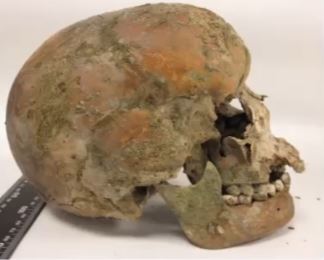Reports, Papers and Other Resources
The Society publishes reports on all of its lectures, some of its visits, selected members papers and suggested reading material in its bookshelf. These can all be found in date order below.
The Society also published a monthly bulletin, the archive for these can be found here.
A talk presented by Professor Mark Horton of the Royal Agricultural University, about the use of drones and aerial photography in archaeology.
- Category: Lecture Reports
- Date: Wednesday, 11 May 2022
- Professor Mark Horton
- Royal Agricultural University
The talk describes the discovery and examination of the skull and skeleton, and discussion of its origin and pathology.
With introduction by Barbara Brockway, member of the CSTS.
- Category: Lecture Reports
- Date: Wednesday, 20 Apr 2022
- Linda Ainscough MSc. ChFA, Chartered Forensic Anthropologist.
A talk delivered to the Cirencester Science & Technology Society by Professor Andy Cundy, on 6th March 2022.
This describes the problem of plastic waste large to microscopic in the oceans, and examines the steps necessary to resolve it.
- Category: Lecture Reports
- Date: Tuesday, 8 Mar 2022
- Professor Andy Cundy
- Southampton University
Professor Michael J. Benton discusses the scientific analysis behind the discovery of the colours of many species of dinosaur, showing what they looked like and how we know.
- Category: Lecture Reports
- Date: Wednesday, 9 Feb 2022
- Professor Michael J. Benton
- Professor of Vertebrate Palaeontology, University of Bristol
Professor Edgar examines some disasters, digs down into the details of the causes, and formulates guidelines to help minimise such risks in future dangerous situations.
- Category: Lecture Reports
- Date: Wednesday, 12 Jan 2022
- Professor Graham Edgar
- University of Gloucestershire
Jim describes his time in Bermuda working to provide drinkinng water to the community, explaining the practical challenges and his solutions.
Full of fascinating details about the hydrogeology of Bermuda and Jim's work to keep this vital element flowing for the residents of Paradise!
- Category: Lecture Reports
- Date: Wednesday, 8 Dec 2021
- Jim Thomson MSc DIC (Imperial), MSc (Birmingham)
- CSTS Member
Dr. Caggiano described the chemical weapons used by some plants to protect themselves from attack by insects, and how those chemicals can be used to find new treatments for cancers.
Sadly the video of this talk is not available.
- Category: Lecture Reports
- Date: Wednesday, 10 Nov 2021
- Dr Lorenzo Caggiano
- Senior Lecturer, Department of Pharmacy & Pharmacology, Bath University
Professor du Sautoy uncovers some of the pitfalls in our thinking processes, and offers some strategies to help us make better decisions.
- Category: Lecture Reports
- Date: Wednesday, 13 Oct 2021
- Professor Marcus du Sautoy OBE FRS
- Charles Simonyi Professor for the Public Understanding of Science and Professor of Mathematics, Oxford University
Joss outlines the complex topic of DNA manipulation using CRISPR and cas-9, and shows how it could be used to create new weaponns against bacteria.
- Category: Lecture Reports
- Date: Wednesday, 8 Sep 2021
- Joss Lazenby BSc
- University of Reading · School of Biological Sciences
Robert shares his painstaking work to understand the computer's construction and capability, and shows how it saved the mission from disaster.
- Category: Lecture Reports
- Date: Wednesday, 9 Jun 2021
- Robert Willis, Software Engineer
- Cisco, Harpenden








